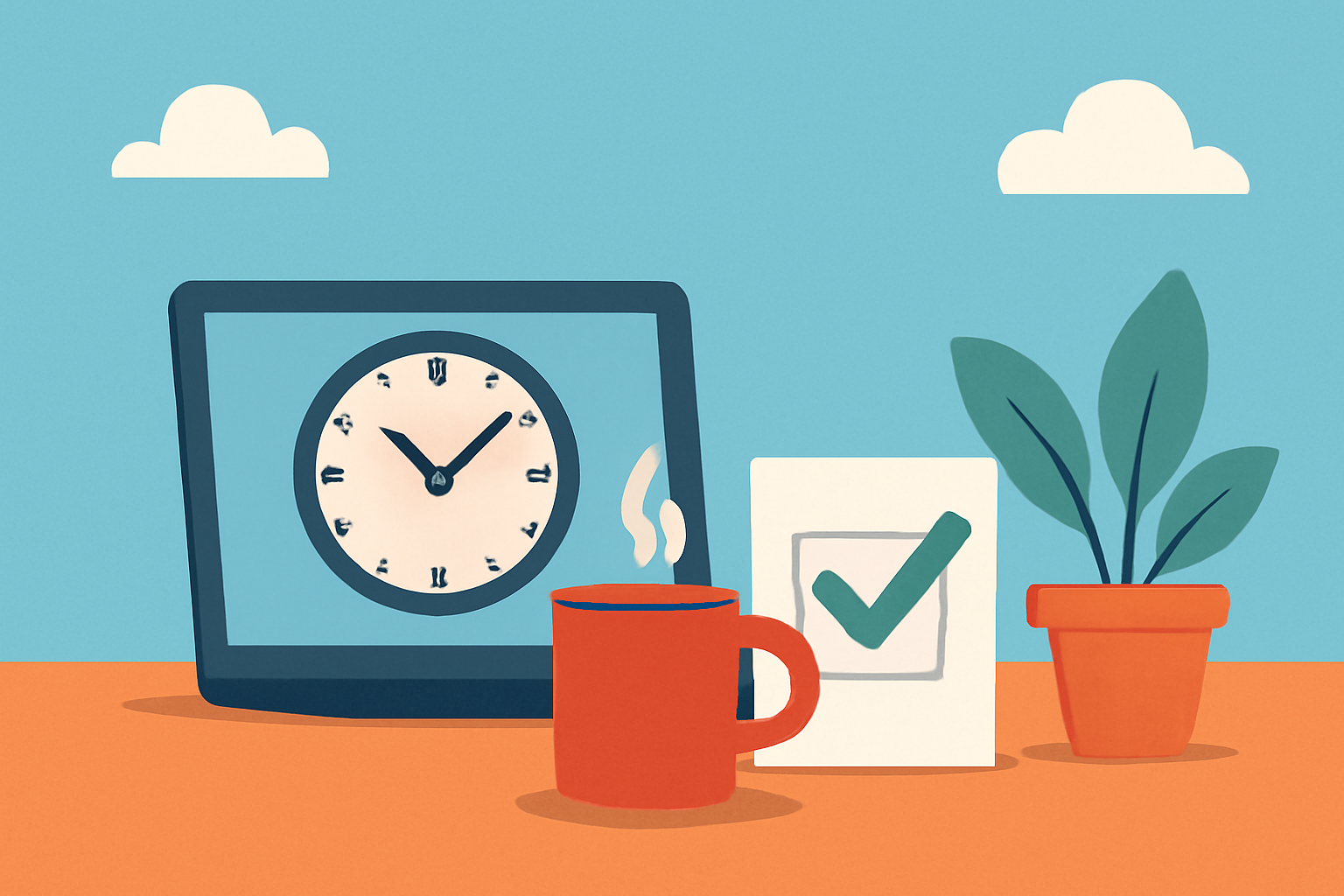Hustle culture glorifies non-stop work — but science says that’s a trap. Studies show taking strategic breaks doesn’t just prevent burnout — it actually supercharges productivity and focus. If you’re not scheduling downtime, you’re likely sabotaging your own output. Learn how the importance of taking breaks can change the way you work, and how to do it the smart way.

The Hidden Cost of Non-Stop Work
The glamorization of overworking has reached an all-time high, especially with remote work blurring lines between professional and personal lives. But working longer hours without rest doesn’t mean working better. In fact, according to Harvard Business Review, continuous work without sufficient rest leads to fatigue, decreased attention span, and ultimately lower-quality results (Harvard Business Review, 2023).
The World Health Organization even labeled workplace burnout as an official occupational phenomenon — a clear sign that global work culture is pushing boundaries too far. Ignoring breaks means you’re not just burning energy — you’re burning out, fast.
The Science Behind Taking Breaks
Our brains are not wired for extended concentration. The prefrontal cortex — the area responsible for critical thinking and decision-making — has limited stamina. When taxed too long, it slows down, leading to mistakes, poor judgment, and mental fog.
A study published by the University of Illinois revealed that brief mental breaks actually help maintain consistent performance throughout a task, suggesting that the brain benefits from rest more than we think (University of Illinois, 2011). Whether you’re coding, designing, writing, or managing teams, mental breaks reset your cognitive clock.
Break Smarter: Top Techniques That Work
1. The Pomodoro Technique: Small Sprints for Big Wins
This time-management method has been a game changer for productivity nerds — and for good reason. Created in the late 1980s, the Pomodoro Technique involves:
- Working for 25 minutes
- Taking a 5-minute break
- After 4 cycles, taking a longer 15–30-minute break
The rhythm creates urgency and blocks distractions. According to Verywell Mind, this technique not only boosts focus but also reduces procrastination and fatigue (Verywell Mind, 2023).
2. The 52/17 Rule: The Productivity Sweet Spot
Based on a study from the Draugiem Group using time-tracking software, the highest-performing workers were found to work in 52-minute sprints followed by 17-minute breaks. The logic? Longer focus periods allow deep work, while generous breaks refresh the mind enough to maintain top performance throughout the day (Wikipedia, 2024).
3. Micro-Breaks: The Underrated Hero
Micro-breaks — under 10 minutes — might seem insignificant, but they’re not. Short pauses for stretching, walking, or just standing up can significantly reduce physical strain and mental tension.
According to Time magazine, micro-breaks improve employee well-being, reduce musculoskeletal discomfort, and enhance alertness — particularly for desk jobs (Time, 2022). The key is frequency: the more consistent your breaks, the more benefits you’ll reap.
Break Routines That Actually Work
It’s not just about taking breaks — it’s about how you take them.
1. Physical Movement
Sitting too long damages your body. Use your break to stand up, stretch, or take a brisk walk. Even five minutes of physical activity can increase energy levels and combat sedentary side effects.
2. Digital Detoxing
Scrolling Instagram isn’t a break — it’s a dopamine trap. Real rest comes when you step away from screens. Try focusing on something analog: nature, music, or even silence.
3. Mindfulness and Breathing
Deep breathing and mindfulness practices can reset your nervous system in minutes. Apps like Headspace and Calm offer quick exercises that help decrease cortisol levels and improve focus.
4. Power Naps
Yes, napping is productive. A NASA study found that a 10 to 20-minute nap improved alertness by 100% in pilots and astronauts. Just make sure you don’t go over 30 minutes to avoid grogginess.
Why Employers Should Encourage Breaks
Forward-thinking companies are already jumping on this trend. Google offers “nap pods,” and SAP encourages walking meetings. And there’s data to support it: companies that implement structured break strategies see up to a 20% increase in productivity (Harvard Business Review, 2025).
Moreover, breaks help reduce absenteeism, improve morale, and retain talent. When people feel mentally fresh, they’re not only more productive — they’re also happier.
How to Implement Breaks Without Feeling Guilty
Many professionals skip breaks because they associate them with laziness. But science has flipped that narrative. To overcome the guilt:
- Schedule breaks like meetings: Set a timer if needed.
- Communicate your break policy: If you’re leading a team, model the behavior.
- Use breaks as rewards: Completing a task? Reward yourself with a breather.
Trends to Watch: The Rise of “Break Tech”
Startups are now creating tech to promote better break habits. Apps like Focus Booster and RescueTime track your productivity and prompt timely pauses. Smartwatches offer movement reminders, and Chrome extensions can temporarily block distracting websites during work sprints.
Expect to see more integrations with AI to personalize break schedules based on real-time stress levels, calendar data, and screen time metrics.
Conclusion: Work Less, Achieve More
The importance of taking breaks isn’t just a wellness mantra — it’s a productivity strategy backed by science. Whether you use the Pomodoro Technique, the 52/17 Rule, or frequent micro-breaks, incorporating structured downtime into your day will make you sharper, healthier, and more efficient.
Remember, your brain needs space to breathe. When you honor that, it performs at its peak.
References
- Harvard Business Review. (2023). How to Take Better Breaks at Work, According to Research. Available at: https://hbr.org/2023/05/how-to-take-better-breaks-at-work-according-to-research (Accessed: 14 May 2025).
- Verywell Mind. (2023). Pomodoro Technique: History, Steps, Benefits, and Drawbacks. Available at: https://www.verywellmind.com/pomodoro-technique-history-steps-benefits-and-drawbacks-6892111 (Accessed: 14 May 2025).
- Wikipedia. (2024). 52/17 Rule. Available at: https://en.wikipedia.org/wiki/52/17_rule (Accessed: 14 May 2025).
- Time. (2022). How ‘Micro-Breaks’ Can Help You Feel Better at Work. Available at: https://time.com/6210430/micro-breaks-work-productivity (Accessed: 14 May 2025).
- Harvard Business Review. (2025). A Guide to Taking Better Breaks at Work. Available at: https://hbr.org/2025/02/a-guide-to-taking-better-breaks-at-work (Accessed: 14 May 2025).









